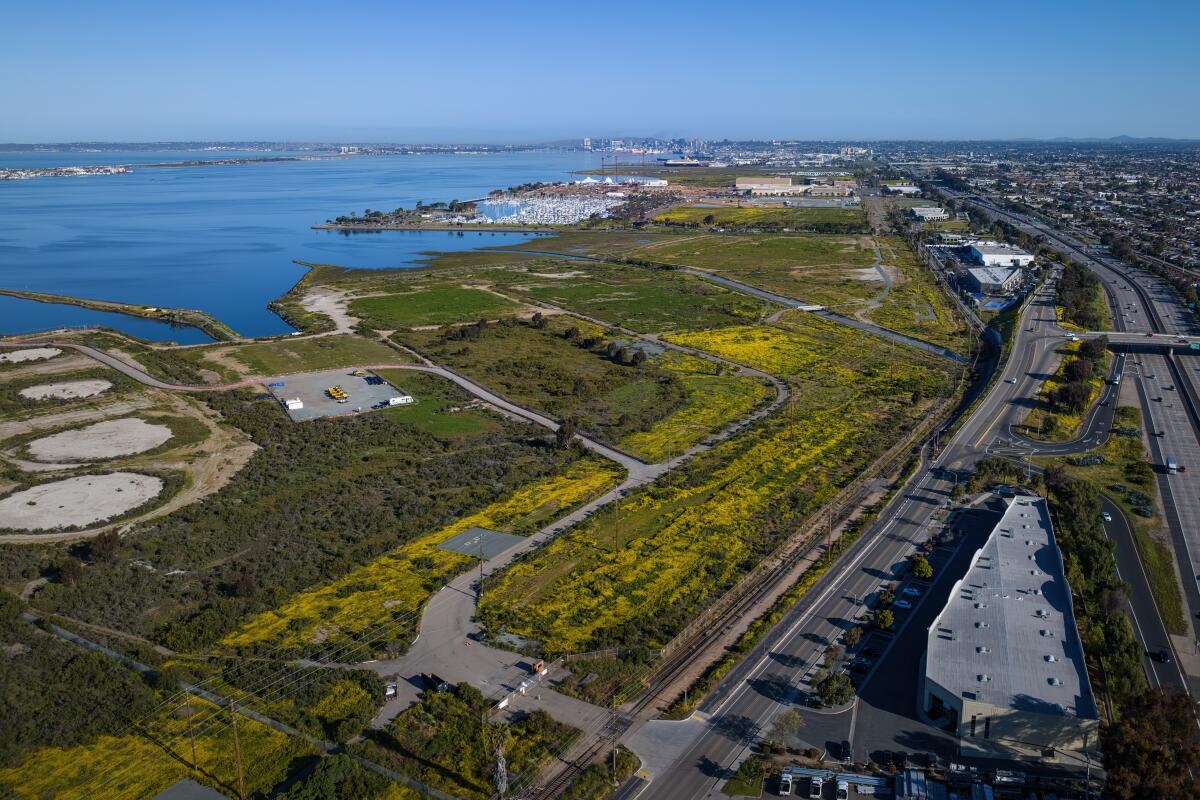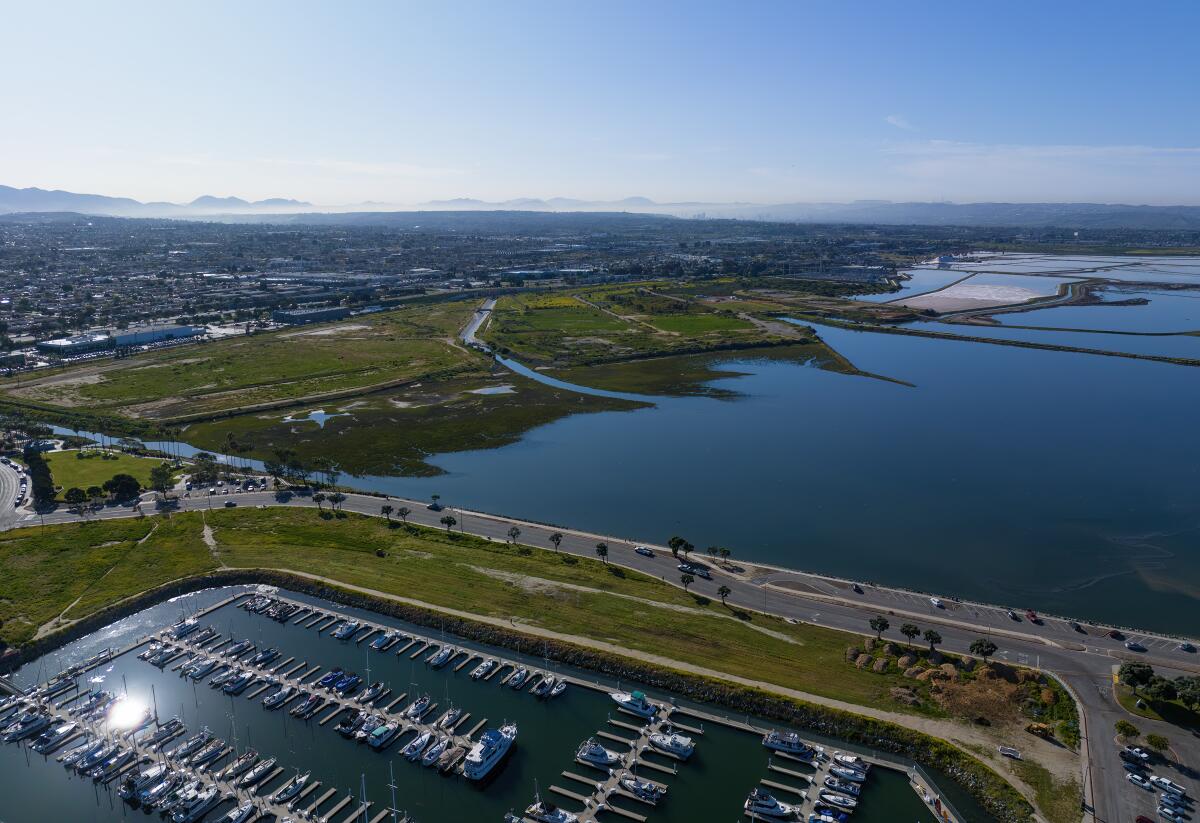Group pitches $2.5-billion MLS stadium and sports complex on Chula Vista Bayfront in San Diego County

Petra Development says it wants to privately finance and build an expansive sports and entertainment complex anchored by the nation’s largest, soccer-specific stadium.
- Share via
San Diego — An investor group that is said to have long eyed ownership of a Major League Soccer franchise is pursuing a long-shot venture to build the nation’s largest, soccer-specific stadium with up to 50,000 seats and two attached hotels on a 136-acre portion of the Chula Vista Bayfront formerly occupied by a power plant.
The proposal is being floated by Petra Development Group, a limited liability company formed solely to secure a Major League Soccer team to play at a future facility on the currently vacant site in San Diego’s South Bay.
This story is for subscribers
We offer subscribers exclusive access to our best journalism.
Thank you for your support.
The group is, for the first time, speaking publicly about its full intent to privately finance an expansive, $2.5-billion sports and entertainment complex on the Chula Vista Bayfront with the MLS stadium and hotels complemented by an athletic training center, shops and restaurants, an esports venue, practice fields for youth leagues and specialized office buildings.
“This project would transform the former power plant site, which is to the south of the Gaylord Pacific resort hotel and convention center, and set a new standard for entertainment venues with community benefit,” said Frederick McDonald, who is the CEO of Petra Development and claims to have a background in large corporate acquisitions. “This proposal is much more than a stadium — it’s a dynamic, mixed-use project that will honor the rich cultural diversity of South Bay, support youth sports, and advance the performing arts, blue tech research and civic pride.”
Petra Development is backed by mostly unnamed private investors. McDonald is said to have made in 2006 an unsuccessful attempt to acquire the D.C. United professional soccer club, and has been scouting for opportunities in other markets, including San Diego, ever since.
The latest bid is substantial. It could already be doomed to fail.
“Major League Soccer believes San Diego could be a terrific market for a future expansion team. We’re not in any discussions regarding a stadium in Chula Vista,” said Dan Courtemanche, who is executive vice president of communications for the organization.
The unequivocal statement doesn’t appear to have swayed the development team from pressing forward.
“We’re prepared to invest the time and resources necessary to bring this vision to life,” McDonald said. “Our proposal is designed to the highest standards for sports facilities and has already attracted interest from teams in the U.S. and Mexico. While our ideal partner would be MLS, we will continue our discussions with leaders of sports organizations as we determine our next steps.”
The team must first direct its attention to securing the land, which is controlled by the Port of San Diego.
The project site, known as the Otay District within the Chula Vista Bayfront Master Plan, is south of the billion-dollar Gaylord Pacific Resort and Convention Center currently under construction. The desired real estate extends from south of J Street to north of where Naples Street would intersect the site, and is west of Bay Boulevard and Interstate 5. It was once looked at as a potential stadium location for the former San Diego Chargers. The property, which housed the South Bay Power Plant before it was demolished in 2013, is not currently being advertised by the port for lease or redevelopment.
The Port of San Diego has permitting authority, subject to review and approval by the California Coastal Commission. The agency’s board has yet to consider the proposition.
In January, Petra Development submitted an unsolicited proposal to the port. The agency initially planned to schedule a special board meeting on Jan. 31 to consider the unprompted ask but instead kicked the plan back to the development team. The door, however, appears to remain open.
“We understand from Petra that they are going to be providing more information. When we get it, we will review it and determine potential next steps,” a spokesperson for the port said.
It is rare for the agency to move forward with unsolicited development proposals.
“Over the last 20 years, the port has received several unsolicited development proposals including a Ferris wheel proposal, a barge/restaurant concept, and Wings of Freedom park,” the spokesperson said. “These and other unsolicited projects didn’t ultimately move forward.”
In 2019, the agency entered into an exclusive negotiating agreement with Topgolf International for an East Harbor Island site that was not actively being marketed for lease. But the company had several years earlier responded to a solicitation for the land.
Petra would need to secure a contractual commitment in short order from the port to have a viable MLS plan.
Major League Soccer has telegraphed an intent to select its 30th franchise before the end of the year. League Commissioner Don Garber said in February that San Diego was a top contender for the expansion franchise. The commissioner did not disclose a preference to work with a specific ownership group.
Last year, the Union-Tribune, citing unnamed sources, reported that the local Sycuan tribe had teamed with London-based Mansour Group and was angling to secure a team to play at Snapdragon Stadium. The group is in active negotiations with San Diego State University to play at the recently opened, 35,000-capacity facility.

Petra, however, believes it can entice league officials with a stadium and complex that the team says is second to none. The group has also expanded its roster in recent weeks to prove that can turn its vision into reality.
Most recently, Petra added Virginia Beach-based The Divaris Group as an investor. The commercial real estate brokerage and services firm also signed on as the project’s master developer. The Divaris Group manages or leases more than 37 million square feet of office, retail and industrial space across the U.S., according to its website.
The project’s consultants are also well-known and either familiar with the inner workings of the port or have worked on MLS projects in the past. Lead architect Tucker Sadler Architects designed and helped entitle the Rady Shell at Jacobs Park and Portside Pier, projects that are both on port tidelands. Petra is also working with stadium expert Populous, which designed Allianz Field for Minnesota United FC. The Concord Group is studying the economic implications of the project.
“We believe the Chula Vista Bayfront is an ideal location for a sports facility. Petra Development Group has been pursuing a stadium and entertainment complex, and our firm has invested substantial time and effort in designing a project for this spectacular site,” said Greg Mueller, who is the CEO of Tucker Sadler Architects and created the master plan for Petra’s Chula Vista sports and entertainment complex. “We understood that our proposal had received signals of interest from MLS but our team is also speaking with other potential sports teams that expressed interest in the facility.”
The stadium, Mueller said, would be the first of its kind in the U.S. — not just in terms of its size.
The plan envisions a 40,000- to 50,000-seat, soccer-specific stadium, or nearly double the capacity of a standard MLS-specific facility. That’s because Petra is banking on drawing an audience that crosses into Mexico.
The stadium is also unique in that two, 250-room hotels would be built into the facility. The hotel-to-stadium connectivity is meant to keep the venue alive with activity all year. Rooms facing the facility, and even hotel rooftop decks, would have views onto the field; some floors would provide direct-but-controlled access to the concourse during events; and lobbies with restaurants and shops would share the stadium’s ground floor, Mueller said. The design, he said, is the product of travels to international regions known for soccer, including Brazil, Argentina, Italy, France, Spain and Asia.
Renderings viewed by the Union-Tribune but not released for this story show the stadium and attached hotels wrapped in a blue skin that is intended to double as a sophisticated shading device.
“We can program [the skin] to follow the rise of the tide within the bayfront, and that movement will show how the tide is rising and the blue will get bluer,” Mueller said. “During games, [the skin] may be turned to clear and you’ll see right through it ... . It’ll be lit uniquely in the evenings during games, just to help highlight what is going on inside the stadium. It’s a transparent screen material that allows for the hotel rooms to look right through without any obstruction, even when it’s changing colors. And [the skin] does provide an environmental aspect to each of the hotel rooms from the standpoint of heat gain.”
Beyond the stadium, Mueller engineered a multicultural atmosphere that he hopes is inviting to people independent of stadium activity. A so-called “festival retail” experience with restaurants and shops, inspired by Mexico’s Tlaquepaque shopping district, would traverse the northern expanse of the project site. The retail street feeds toward a watershed that the development hopes to amplify with an educational river walk. And, east of the stadium, the proposal envisions office buildings designed for environmental and ocean-related research outfits. Altogether, the plan envisions 1.1 million square feet of retail and office space.
Additional features include a performing arts building tailored for esports tournaments, youth soccer fields for a variety of different age groups, and a training center with a pool that caters to both athletes and community members.
Design-wise, everything, Mueller said, is meant to reflect the qualities of the waterfront and the cultures within Chula Vista.
The project, which was presented to Chula Vista City Council in a redacted fashion in August, has garnered the support of city officials, including Chula Vista Mayor John McCann.
“The Petra stadium and entertainment complex would imbue the site with vibrant activity with the stadium, hotel, restaurant, sports fields, wellness/aquatic center, performance center, blue tech, entertainment, retail and more,” McCann wrote in a letter of support sent to Port Chairman Rafael Castellanos in January. “Tying into the Bayshore Bikeway and the Bayfront greenbelt for cyclists and pedestrians, this project would include many public benefits including youth sports fields, swimming lessons, sailing lessons, and other affordable opportunities for youths to participate in low-cost/no-cost physical activities.”
Port Commissioner Ann Moore, who introduced the item at the August Chula Vista City Council meeting, also appeared to be in support of the endeavor.
San Diego Union-Tribune staff writer Tammy Murga contributed to this report.
More to Read
Sign up for Essential California
The most important California stories and recommendations in your inbox every morning.
You may occasionally receive promotional content from the Los Angeles Times.













